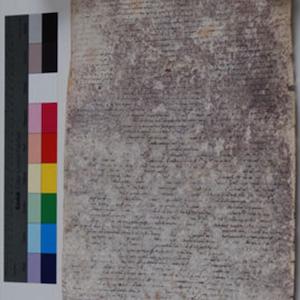Ancient documents decay over time. Understanding the underlying cause of the deterioration is obviously necessary to prevent or reverse it.
Many ancient documents were created on parchment, which is derived from animal skin. Over time, parchments can be covered in purple spots, making the documents unreadable. (See upper left image.) For the past 40 years, scientists have tried to figure out what was responsible for the splotches, but little progress was made. But now, a team of mainly Italian researchers believes it has identified a potential cause.
The authors obtained a nearly 800-year-old, 5-meter-long parchment from the Vatican Secret Archives that details the story of a young soldier who accidentally killed a man and went into a self-imposed exile for 34 years. The parchment had both damaged and undamaged spots, so the researchers were able to compare them using DNA and sequencing and chemical analysis.
DNA sequencing revealed that the purple spots contained greater microbial diversity. The undamaged spots were dominated by the bacterial order Pseudonocardiales. This order was also present in the purple, damaged spots, but these spots also contained a higher fraction of different bacteria, such as Vibrionales. (Incidentally, this bacterial order includes the infamous Vibrio cholerae, the etiologic agent of cholera.) Many of the bacteria were to tolerant to high levels of salt, which makes sense because the process to create parchments from animal skin involves salt treatment.
Chemical analysis showed that the purple spots were due to pigments, such as bacteriorhodopsin, that are used by bacteria to perform their version of photosynthesis and to protect them from UV damage. Further analysis showed that parchment with purple spots displayed a greater deterioration in some of the molecules that make up the parchment (e.g., collagen fibers).
 Taken together, the authors believe that no single microbe is responsible for destroying ancient parchments. Instead, they believe that a succession of microbial communities causes the damage. Over time, the members of the community shift, and the newcomers are likely responsible for the purple spots*. (See figure on right.) A similar phenomenon can happen in human neighborhoods. Over time, a community can change from good to bad. No single person is responsible; but over time, the character of the neighborhood changes.
Taken together, the authors believe that no single microbe is responsible for destroying ancient parchments. Instead, they believe that a succession of microbial communities causes the damage. Over time, the members of the community shift, and the newcomers are likely responsible for the purple spots*. (See figure on right.) A similar phenomenon can happen in human neighborhoods. Over time, a community can change from good to bad. No single person is responsible; but over time, the character of the neighborhood changes.
In this case, the authors hypothesize that purple, salt-loving microbes (Halobacteria) are the first to grow, and then, as they die off and leave purple stains behind, other environmental microbes move in. This insight, combined with further research, may help archivists and museologists restore damaged parchments.
*Note: This so-called "microbial shift" is also thought to be the cause of conditions like periodontitis and inflammatory bowel disease. For more on this topic, see this review article I wrote.
Source: Luciana Migliore, Maria Cristina Thaller, et al. "Purple spot damage dynamics investigated by an integrated approach on a 1244 A.D. parchment roll from the Secret Vatican Archive." Scientific Reports 7, Article number: 9521. Published: 7-Sept-2017. doi: 10.1038/s41598-017-05398-7




